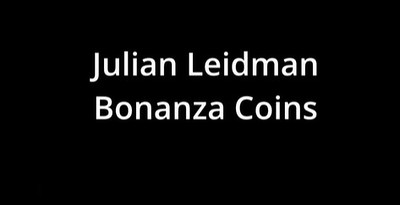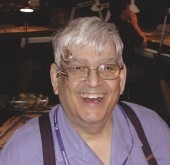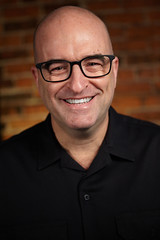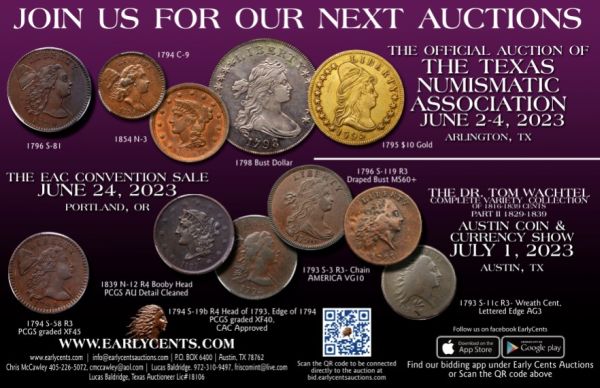
PREV ARTICLE
NEXT ARTICLE
FULL ISSUE
PREV FULL ISSUE
JULIAN LEIDMAN INTERVIEW, PART THREEGreg Bennick's latest interview for the Newman Numismatic Portal is with dealer Julian Leidman. Here's the third part, where Julian talks about auctions and the famous Eliasberg sale. -Editor Greg Bennick: That's great. I love the backstory on the bidder representation, because that was something I was going to ask you about as well, because I know that you've been doing that for quite a long time, and I was going to ask you how the process works. We just got some insight into that. And then also, I was going to ask - and you gave us insight into this too - about what happens when you're representing multiple bidders at once, how you keep everyone's bids straight in your mind, and what happens if you have conflicting bids. And you just gave us a perfect example of what happens in those situations.
Greg Bennick: I was going to ask, what was the room like? What was that like? Julian Leidman: Unbelievable is what it was. I mean, it was absolutely packed, totally unlike auctions today. Auctions today are on the internet, and the last people that have really held live auctions have sometimes only had half a dozen people in the audience. Which is very disappointing to me as a long-time aficionado of auctions, and enjoying that, being able to see who's buying what, etc. Also at the Eliasberg sale, were Brent Pogue and his father Mack. They bought coins there too. They had been buying, really, since the late 70s. Mack was putting up all the money, Brent was just a teenager. But he had his mind on what he wanted, and it was very... as it turned out, in that sale, Harry got the 70 S three-dollar piece for $687,500, and Brent got the 1822 Half Eagle also for the same price. So, these are both- Harry and Mack were both part of the Dallas fixture of numismatics. Of course, they knew each other, but they dealt with each other just fine. Mack was involved in real estate, and Harry was involved with oil, so they didn't have business conflicts or anything like that. But that auction in New York city for the Eliasberg gold was really something. Greg Bennick: I'm glad you were there, I'm glad you could share a little bit about that. I just imagine a spirited room with bid cards going up, and people yelling and screaming. Julian Leidman: Exactly. You know, when I had all those people, I didn't bother with the bid cards. I'd just bid, and then I'd look up what the number of that bidder was. I had to look up who was who. And I got coins for, I'm sure at least half a dozen or a dozen people. They all didn't get something, but that was another interesting auction in that, after the fact, I learned that there was kind of a minimum on every coin, and the Eliasberg family got back some coins after that. Greg Bennick: Because they didn't meet the reserve...? Julian Leidman: They were actually in the hotel watching by closed circuit, so they knew what was going on also. Many years later, I met one of Eliasberg's sons, Richard, and became pretty friendly with him. He would come to coin shows in Baltimore, because that's where his business was. But I met him there, and I did business with him subsequently. You know, I got some of the small collection of currency he had, and different things like that. But they had a subsequent sale along with Stack's Bowers in the late 90s, where they sold the non-gold coins. Greg Bennick: Were there other auctions? I didn't plan to ask you about auctions, it's great that we're talking about it. I planned to ask about bidding for people, but not the spirit of the room, and some of these auctions. For example, I've got a set of Eliasberg catalogs - well, hurray. The energy isn't in the catalog, the energy is in your story about the catalog. Are there any auctions that you remember attending over the years, years ago, that exist now only in catalog form, that you remember as being spirited, or energetic, or exciting, or ones where there were sales that were just so memorable that they stuck in your mind? Julian Leidman: Oh, yeah. I'd go back even to... I guess it was 1970 in St. Louis. RARCOA had the auction- I think it must have been the Central States Show, or maybe not, I don't quite remember. They had some beautiful large cents. And I remember this one large cent, 1824 over 2 large cent in uncirculated condition, went just crazy, crazy, crazy. And of course, I learned later that Ted Naftzger got that coin, and he wasn't gonna be beat out either. You remember certain auctions. Of course, over the years, I attended virtually all the Stack's auctions that were in Manhattan. I would go to New York once a month for auctions for Stack's. Lester Merkin had some gorgeous sales there. And it was just- it was part of my routine. Attending the Bowers and Ruddy sales in California, there were maybe 50 people in the room or something like that. I was a continuous buyer there. I remember buying the 1793 half-cent because it was the first lot in every auction. I bought it two or three times because it was the first one. I'd often have pages on an invoice and stuff. Of course, the auction houses at the time, you built up your experience with them, and they would extend you a little bit of credit, and so you could work it out. But it was never really more than a month, because they normally had to settle in 45 days. And so, you could get a little bit of credit from them, and that helped me a lot at that time. There's no question about it.
To watch the complete video, see:
To read the complete transcript, see:
To read the earlier E-Sylum article, see:
Wayne Homren, Editor The Numismatic Bibliomania Society is a non-profit organization promoting numismatic literature. See our web site at coinbooks.org. To submit items for publication in The E-Sylum, write to the Editor at this address: whomren@gmail.com To subscribe go to: https://my.binhost.com/lists/listinfo/esylum All Rights Reserved. NBS Home Page Contact the NBS webmaster 
|



